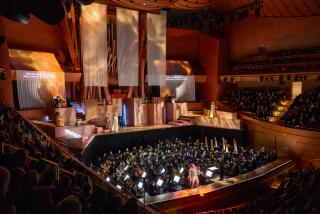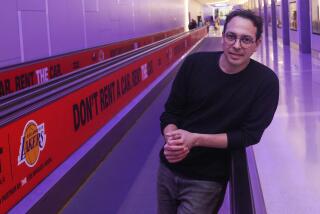‘Songs of Ascension’ takes flight at REDCAT
When the musician Meredith Monk and the visual artist Ann Hamilton first worked together in 2001, they created “Mercy,” a work that was described variously as dance, opera, musical theater and installation art. The performance was a meditation on violence and fear, conceived in response to a photograph of a Palestinian family who had been victims of Gaza Strip crossfire. To illustrate its big themes, Hamilton placed a micro video camera in Monk’s mouth, and a group of women sang into a soap bubble the size of the stage.
For both women, an integrated approach to “sight, sound, touch, smell -- everything,” as Monk puts it, is what defines them as artists. Each has a reputation for disregarding the boundaries of mediums. In Monk’s case, music is only the most conspicuous aspect of her art, which incorporates choreography, film, layers of mythological context and her own ritualistic acting style. “To explain my thought process, I like to talk about the dancing voice and singing body,” she says. Hamilton, for her part, combines in her work found sound, light, cloth, words and architecture.
After “Mercy,” in fact, Hamilton built an eight-story, silo-like tower in Geyserville, an hour north of San Francisco, and then asked Monk to sing at the tower’s inauguration. But the space’s spiral staircases and rich reverberations inspired Monk to conceive an entirely new work with Hamilton, titled “Songs of Ascension.” Monk would direct, compose music and dance, and Hamilton would produce video art. Tonight, in a considerably different form, the result will begin a five-performance run at REDCAT.
Earlier this month, Monk sat in the field that surrounds Hamilton’s tower and discussed the nature of ascension: how it relates to the human DNA’s double helixes and to spiritual rituals. “Why is God always considered up -- in the sky?” she asked. “What is it about ascension that has intrigued religious practice?” She was on a break from rehearsing for a site-specific performance of “Songs” as part of a tour that has included the Walker Art Center in Minneapolis and Stanford University and that will continue until March, when she will adapt the work for New York’s Guggenheim Museum, with its own variation on the spiraling staircase theme.
Monk considers herself primarily a “music maker.” She resists terms such as “avant-garde” and “composer,” both of which suggest a tradition of notated sheet music at odds with her more intuitive creative process. Despite this, she works under the superficial umbrella of modern composition, releasing piano music, accepting commissions from such performers as the Kronos Quartet and Michael Tilson Thomas and issuing almost all her music on the jazz and classical label ECM.
She is a fourth-generation singer, but one with a preternatural grasp of so-called “extended vocal techniques.” In that way, she follows in the path of such vocalists as Cathy Berberian, who helped expand the human voice’s expressive potential. Her works often orbit around her a capella vocalizations, which hint at yodeling, ethnic chants and early church music but rarely sound like traditional Western singing. “I try very hard to create new worlds,” she said. “I avoid standard linear structures and instead allow bits and pieces of sound to spiral back around again in a new way.”
Monk, 66, has watched pop singers such as Björk and Mike Patton adopt her techniques, has won a MacArthur “genius” grant and has contributed to film scores, but she continues to inhabit a private niche, isolated from modern trends. She is often discussed in the same breath as Philip Glass and Steve Reich, as a Minimalist, but the association indicates only a partial picture of her work and mostly refers to the mid-’70s period when all three composers’ music developed. “I want my art to be an antidote to the speed and diversionary tactics of a culture that is basically trying to put you to sleep,” she said.
Just as Monk encourages “new modes of multi-perception” in audiences, Hamilton, 52, talks about her installation pieces as “sensory surrounds” and considers art a tool for revitalizing the senses. When creating her art, she prompts herself with questions: “Can material form be a way of looking?” or “What does it mean to be a reader?” In the past, she has answered these questions through the use of Braille, or the archaic record-keeping method of tying knots on string, or pinhole mouth cameras, which control the film exposure through the opening and closing of her mouth, viscerally connecting light and voice.
Monk and Hamilton often speak of “the immersive experience.” “How do you make the audience be immersed in the experience, rather than just spectators?” Monk asked. “When you think about this, you start thinking about the volume of the whole space instead of just the stage.”
In the case of “Songs of Ascension,” the players are continuously drifting throughout the space, first materializing from among the audience, then dispersing around the room and locking into a swaying trance with Monk as she howls and hoots. Featuring 11 performers, a chorus, a string quartet and a Laotian wind instrument called a khaen, the piece moves from dead silence to borderline cacophony over an hour of linked musical movements that, despite the title, are more like variations than songs. Meanwhile, Hamilton’s videos blink in the background, serving as what the two women call “the weather of the piece.”
Sitting in the Geyserville field, Monk acknowledged that she has found it difficult to give up total control in her collaborations with Hamilton. But she has decided, she said, that the best approach to collaborative work is to “let go of your territory and coexist with each other in the same space.” She is a Buddhist, and that sensibility is evident not just in her affinity for incantations and meditative silence but also in her thematic explorations of religious practices. “Songs of Ascension” embodies the cross-religious tradition of worship songs and, in that way, is one of Monk’s many manifestations of “art as spiritual practice.” Even while sitting in the midday heat, tired from an ebbing virus, she gave off the same impression of prayer-like mindfulness and composure that has characterized her entire 40-year career.
“My music is an internal experience,” she said. “It puts you on a different emotional range. Hopefully, it helps you to feel awake and alive and present, and I think Ann would say it in the same way. You want work to have a sense of presence and to allow the people who experience it to have a sense of their own presence. I want my work to be of benefit to people, and that’s about all you can do.”
Simonini is a freelance writer.
More to Read
The biggest entertainment stories
Get our big stories about Hollywood, film, television, music, arts, culture and more right in your inbox as soon as they publish.
You may occasionally receive promotional content from the Los Angeles Times.






